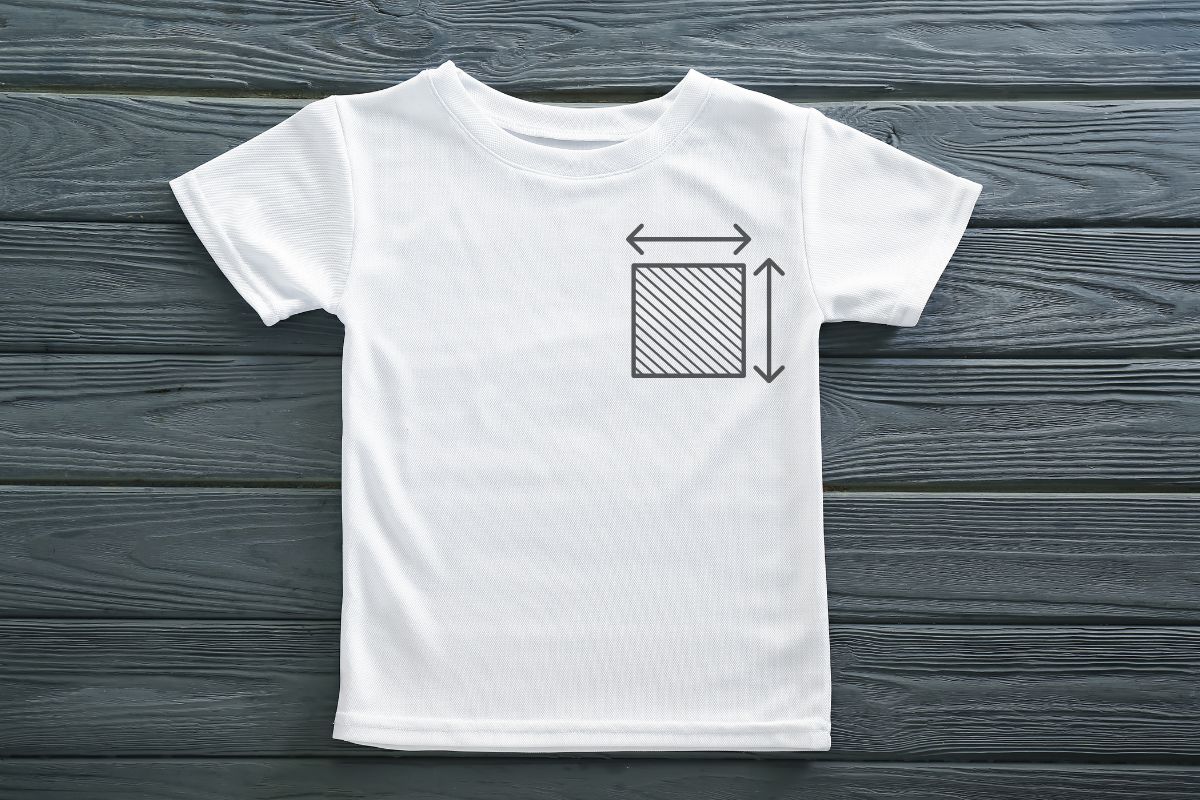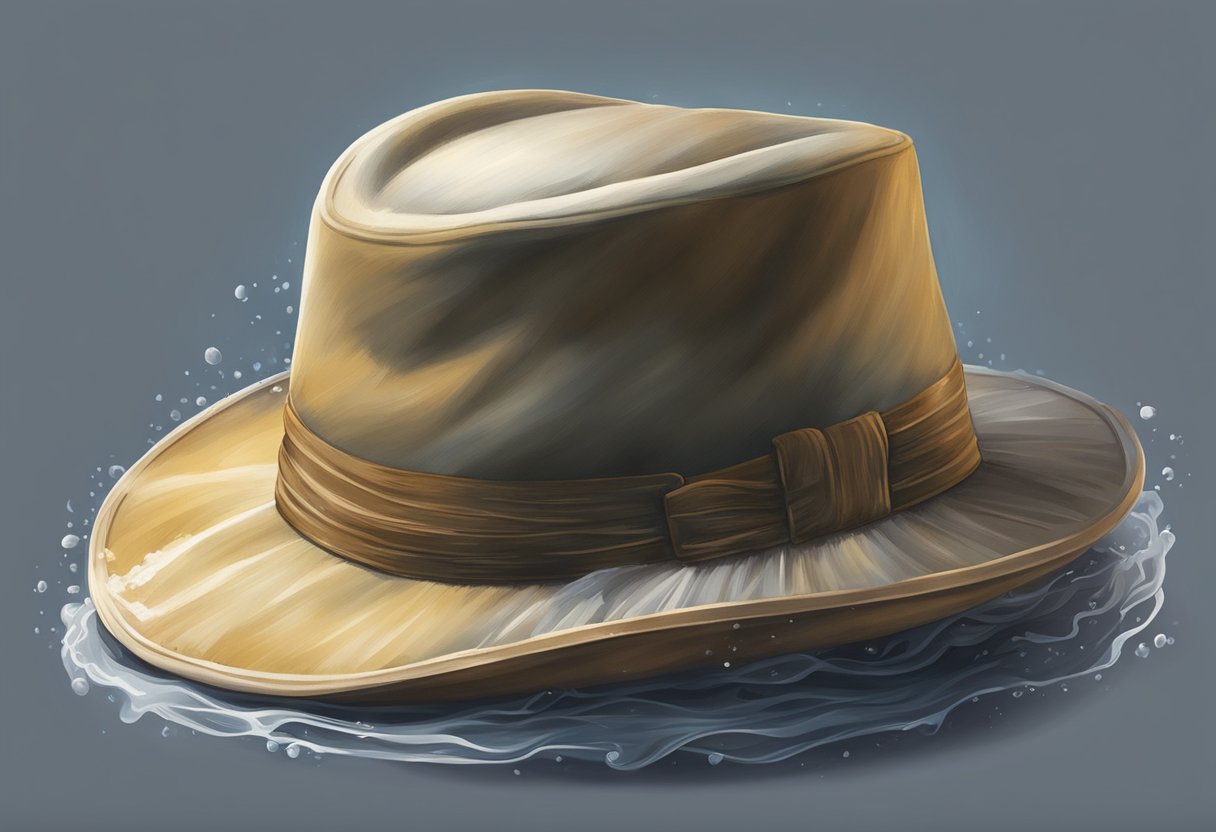When you’re designing a custom T-shirt, one of the most crucial aspects to consider is the logo size. The average size of a left chest logo is typically between 3 to 4 inches in width. This size ensures the logo is visible without overwhelming the design of the T-shirt itself, making it ideal for branding purposes.
Choosing the right size for your logo can greatly impact how your T-shirt looks and how your brand is perceived. A logo that’s too small might go unnoticed, while one that’s too large can look unprofessional. Finding that sweet spot of 3 to 4 inches helps to maintain a balanced and appealing look.
There’s also the importance of considering the type of T-shirt style and the printing method. Different fabrics and cuts can affect how the logo appears and how it needs to be printed. Ensuring proper placement and sizing is key to creating a shirt that not only looks great but also effectively communicates your brand.
Key Takeaways
- Average left chest logo size is 3 to 4 inches wide.
- Proper logo size enhances T-shirt design and branding.
- T-shirt style and printing method affect logo appearance.
Understanding Logo Placement on T-Shirts
Proper logo placement on t-shirts is essential for making a lasting impression. Whether it’s the left chest logo or the center chest logo, understanding the nuances can help you achieve the desired look and impact.
Fundamentals of Logo Positioning
When placing a logo on a t-shirt, the size and position are crucial. A common choice is the left chest area, usually positioned about 3-4 inches from the neckline. This spot is ideal for small to medium-sized logos, generally around 3×3 inches. It ensures visibility without overwhelming the design of the shirt.
Center chest logos are another popular option and typically range from 8 to 12 inches wide, depending on the shirt size. This placement draws attention and is perfect for bold designs. Pay attention to the balance and alignment of the logo to create a cohesive and professional look.
Differences Between Left Chest and Center Chest Logos
Left chest logos are subtle and often used in professional settings. They are usually around 3 inches in diameter, making them perfect for brand names or small emblems. The left chest placement is easily visible during interactions, making it ideal for uniforms or promotional wear.
Center chest logos are more prominent and can be much larger, often taking up to 8-12 inches in width. This placement is best for event t-shirts or casual wear where the design needs to stand out. It gives a more casual and impactful look, suitable for larger graphics or detailed designs.
Choosing between the left chest and center chest logo depends on your branding needs and the message you want to send.
Designing for Different T-Shirt Styles
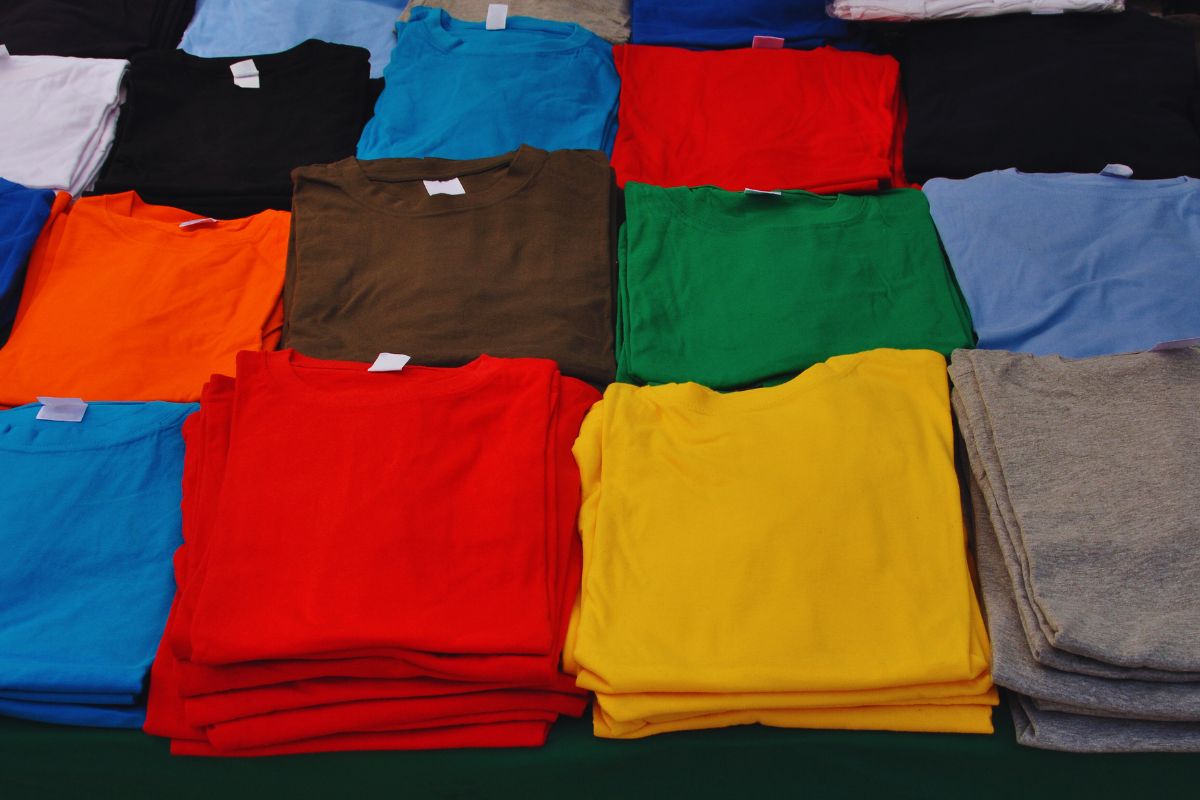
When designing for different T-shirt styles, it’s important to consider the specific needs of each type of shirt. Factors like shirt size, sleeve length, and target audience can all affect the placement and size of logos and designs.
Standard Size Guidelines for Various Shirt Sizes
When placing logos on adult shirts, it’s crucial to follow standard size guidelines to ensure the design is visually appealing. For small to medium-sized shirts, a left chest logo typically measures around 3 to 3.5 inches wide. For larger sizes, such as large or extra-large, logos might increase to about 4 to 4.5 inches. Maintaining these proportions helps your design stay balanced regardless of the shirt size.
Specifics for Polo Shirts and Long-Sleeve T-Shirts
Polo shirts often have a more formal appearance compared to standard T-shirts. When designing for polo shirts, a left chest logo might be slightly smaller, typically around 2.5 to 3 inches wide. For long-sleeve T-shirts, consider the sleeve’s length and placement of other elements. Logos should be as per the standard size but may need repositioning to accommodate for sleeve prints or other design elements.
Adjusting Designs for Youth Shirts and Onesies
Designing for youth shirts and onesies requires additional adjustments. For youth shirts, left chest logos generally measure about 2 to 2.5 inches wide to fit proportionally on smaller torsos. Onesies, due to their unique shape and smaller size, often require logos to be around 1.5 to 2 inches wide. Keeping designs scaled down maintains a balanced look and avoids overwhelming the garment.
Every shirt style and size has unique considerations, and keeping these in mind ensures your designs stand out while fitting perfectly on the garment.
Technical Aspects of Logo Printing
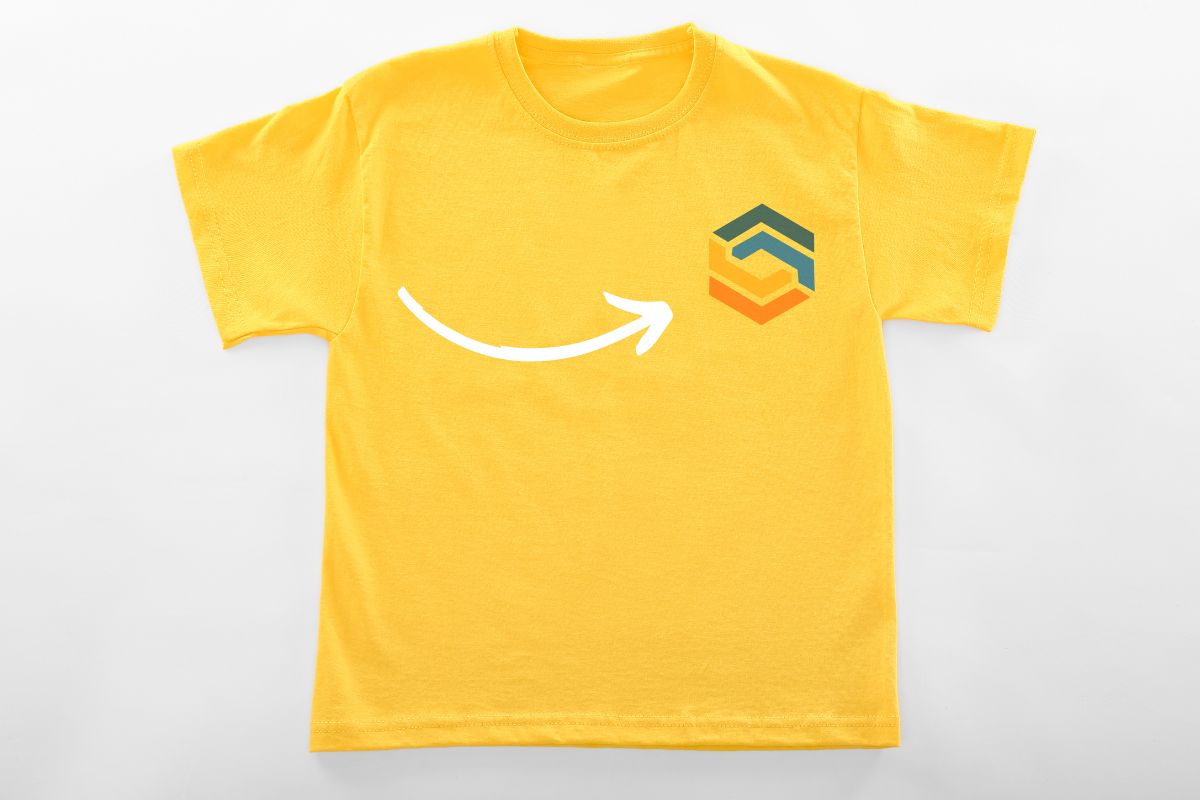
When printing a logo on the left chest of clothing, there are several technical aspects to consider. These include the printing method, image file formats, and quality specifications to ensure the best results.
Screen Printing vs Digital Printing
- Screen printing involves creating a stencil (or screen) and using it to apply layers of ink on the printing surface. It’s ideal for bulk orders and designs with a limited number of colors. The setup time can be longer but offers durable results.
- Direct-to-garment (DTG) printing uses a specialized printer to apply ink directly onto the fabric. This method is suitable for detailed designs and allows for a large range of colors. It has a faster setup time but may not be as cost-effective for large orders.
Embroidery and Heat Transfer Techniques
- Embroidery involves stitching your logo onto the fabric, providing a professional and durable finish. It’s excellent for polos and jackets but can be unsuitable for fine details due to the limitations of stitching.
- Heat transfer techniques use heat to transfer printed designs from a vinyl sheet to the garment. This method is versatile, allowing for vibrant colors and fine details, and is suitable for short-run or custom jobs. The durability of heat transfer can vary based on the quality of the vinyl and the process used.
Image File Formats and Quality Specifications
Image file formats for printing should be high quality. Formats like PNG and JPG are commonly used, with PNG often preferred for its lossless compression and transparency capability.
Quality specifications include the dpi (dots per inch), which should be at least 300 dpi for crisp, clear prints. Low dpi images may appear pixelated or blurry. Ensuring your file is the right size and format helps maintain the design’s integrity during the printing process.
Importance of Logo Size and Branding

Choosing the right size for a chest logo, especially on clothing, is crucial. It impacts not only the shirt’s design but also how well people recognize and remember the brand.
Balancing Logo Proportions with Shirt Design
When it comes to logo size and placement, getting the proportions right is key. Logos that are too large can overwhelm the design, making the shirt look cluttered. Conversely, logos that are too small may be overlooked. A balanced logo size ensures that the design looks clean and the brand remains visible without dominating the shirt.
You should consider the type of clothing material and how it stretches. Fabrics like cotton and polyester may affect how the logo appears when worn. The average size for a left chest logo is typically around three to four inches, which provides enough visibility while maintaining balance.
It is also important to assess where the logo is placed on the shirt. A well-placed logo on the left chest catches the eye without being intrusive, making it easy for people to identify the brand.
Impact of Logo Size on Brand Recognition
The size of your logo directly impacts brand recognition. A logo that is too small may be missed by potential customers, reducing the chance of brand recall. Larger logos are more noticeable, which can enhance the visibility of your brand.
However, you must be careful not to make the logo overly large. An oversized logo can come across as aggressive and may detract from the overall appearance of the clothing. Finding a balance in size ensures that your logo stands out in a positive way.
Also, think about the context in which the clothing will be worn. For athletes or teams, a prominent logo can signify team spirit and unity. For corporate settings, a more subtle logo can convey professionalism.
By carefully considering logo size and its placement, you ensure that your branding efforts are effective and your logo contributes positively to brand recognition.
Placement and Sizing Guidelines
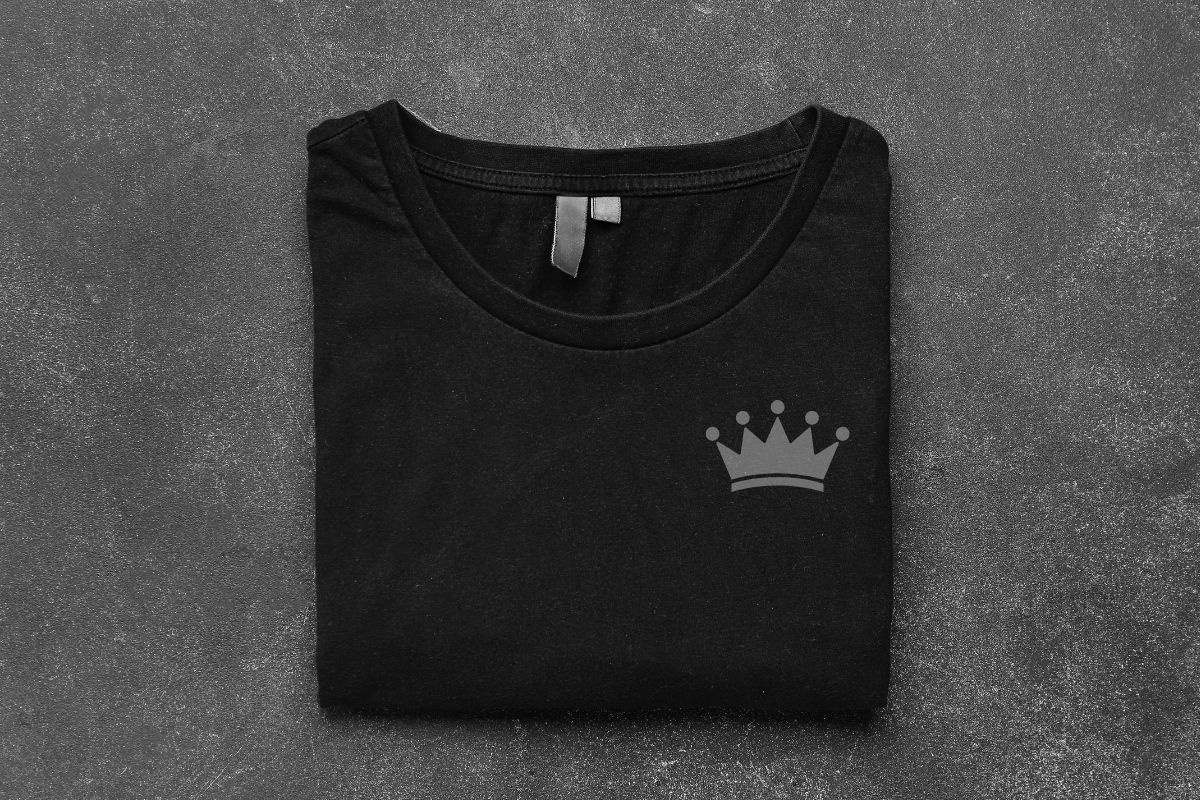
The placement and sizing of a left chest logo on t-shirts involve specific standards and guidelines. These ensure consistency and help in achieving a professional look across all custom and promotional t-shirts.
Standard and Oversize Print Placement
When placing a left chest logo, alignment and positioning are crucial. The standard location for the left chest design is generally about 3 to 4 inches down from the shoulder seam and 3 inches away from the center.
Oversize prints, which are larger than standard, require adjustments. Rather than placing oversized logos in the same spot, you often need to shift them slightly downward. Make sure the artwork doesn’t extend past the chest area to maintain a balanced look.
Properly sizing the logo can make a huge difference. While a standard left chest logo is typically 3 to 4 inches wide, oversized prints might span 5 to 7 inches but should not exceed these dimensions to avoid looking awkward.
The Role of Anchor Points in Consistent Placement
Anchor points are essential in maintaining consistent placement for every t-shirt design. They act as reference points that ensure logos are always positioned correctly.
Using anchor points like the center of the shirt or the seam of the shoulder allows for accurate placement. For instance, a left chest logo commonly uses the intersection of the y-axis from the shoulder seam and the x-axis extending from the armpit as anchor points.
These points provide a clear guide for where to start the design, regardless of shirt size or style. Consistency in placement is vital, especially for promotional t-shirts and branded apparel, to present a uniform and professional appearance.
Utilizing a T-Shirt Design Placement Guide
A t-shirt design placement guide is a valuable tool for correctly positioning logos and designs. These guides offer visual references on where to place logos, text, and images on different parts of the t-shirt.
For left chest logo placement, the guide typically includes measurements and diagrams specifying the exact distances from the shoulder and center. Using a design placement guide ensures the logo doesn’t interfere with other elements like pocket logos or sleeve placements.
In addition to providing clear guidelines for standard sizes, they also help with placement for images and text across various t-shirt types, including short sleeve and long sleeve shirts. This ensures each piece of promotional t-shirt carries a consistent look, whether it’s a pocket logo or a full front design.
Frequently Asked Questions
When designing and placing logos on apparel, it’s important to consider size and positioning to ensure the logo looks professional and remains legible. Here are some key details to help you get it right.
What are standard dimensions for a logo on the left chest of apparel?
For most apparel, the standard dimensions for a left chest logo are 3 to 4 inches wide. These dimensions can vary based on the type of clothing and the overall design.
How do you properly position a logo on the left chest?
A left chest logo is typically placed about 7 to 9 inches down from the shoulder seam and 4 to 6 inches in from the center. This positioning helps the logo sit in the optimal visual spot.
What is an appropriate size for a decal on the left side of a chest?
For decals, the size should generally be around 3 to 4 inches in width. This allows the decal to be easily seen without overwhelming the garment.
How large should a front chest logo be on a t-shirt for optimal visibility?
On a t-shirt, a front chest logo should be about 3 to 4 inches wide. This size provides good visibility while maintaining a balanced look on the shirt.
Can you provide a size chart for logos on various clothing items?
For t-shirts, polos, and jackets, a left chest logo is usually 3 to 4 inches wide. Sweatshirts and hoodies might need slightly larger logos around 4 to 4.5 inches wide. Smaller items like kids’ clothing or caps may require logos to be 2 to 2.5 inches wide.
What are the recommended dimensions for a back logo in relation to chest logo sizing?
Back logos are generally larger than chest logos. If the chest logo is 3 to 4 inches wide, the back logo could be 10 to 12 inches wide for better proportion and visibility. This helps ensure the logo is easily seen from a distance.

